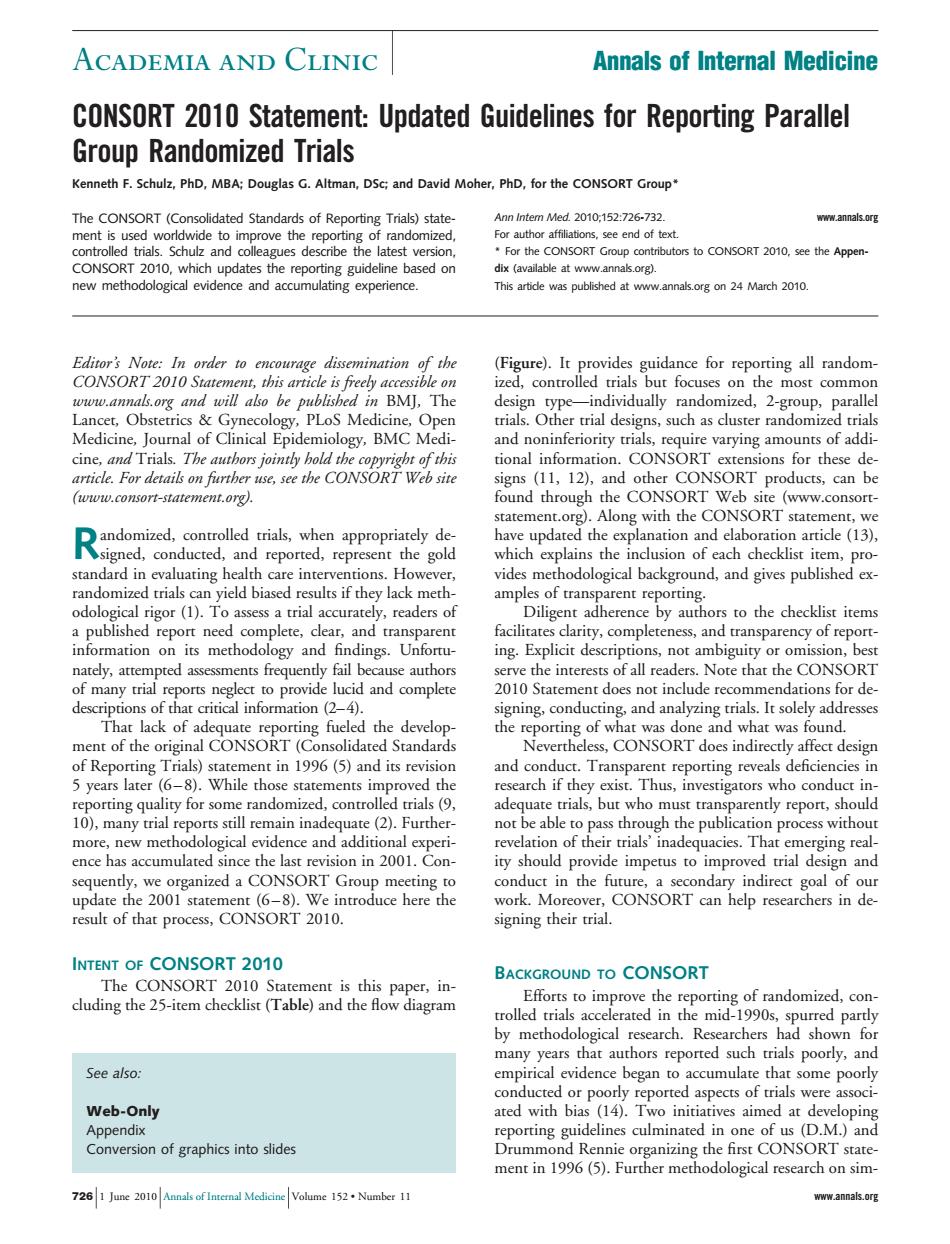正在加载图片...

ACADEMIA AND CLINIC Annals of Internal Medicine CONSORT 2010 Statement:Updated Guidelines for Reporting Parallel Group Randomized Trials Kenneth F.Schulz.PhD.MBA:Douglas G.Altman.DSc:and David Moher.PhD.for the CONSORT Group" ORT IC idated Standards of Rep Ann Intem Med2010,152726-732. rldwide to i the utho eeend of tex CONSORT 201 ruideline based on new methodological evidence and accumulating experience. This artide was published at www.annals org on 24 March 2010. Editor's note:in order to encor dissemination of the (Figure).It provides guidance for reporting all random ized,controlled trials but focuses on the most common ae2.anna在.org andolo PLos人dsdicing othe o ailddando ns,such ed. Trials.The a h CONSORT arying for thes article.For detaiks on fiurther use.see the CONSORT Web site signs (11,12),and other CONSORT products,can be (www.consort-statement.org). found through the CONSORT Web site (www.consort- tatement.org). Alon g with the CC SORT staremen e(13 nd vides,and gives published ex randomized trials can yield biased results if they lack meth amples of transparent reporting. assess a trial nsparency of repo ents freo e the inter t the CONSORT of many trial rports neglect to provide lucid and complete 2010 Statement does not include recommendations for de- d ng conducting,and analyzng sy addresses one and at was found 996512d: orting quality for some randomized,controlled trials(9. adequate trials,but who must trans parently report,should 0).may not b able t nulated sing e in anized a CONSORT Grou update the 2001 statement (6-8).We introduce here the result of that process,CONSORT 2010. signing their trial. INTENT OF CONSORT 2010 BACKGROUND TO CONSORT dang Crlo The CONSORT 2010 Sta in- Efforts to improve the reporting of randomized,con- trolled trials acce ated in the mid-190s by method search.F arc See also: many yer id s poorly. orted as Web-Only ated with bias (14).Two initiatives aimed at dev Appendix Conversion of graphics into slides 721 June 201Amnals ofInternal Modicine Volume 152Number 11 CONSORT 2010 Statement: Updated Guidelines for Reporting Parallel Group Randomized Trials Kenneth F. Schulz, PhD, MBA; Douglas G. Altman, DSc; and David Moher, PhD, for the CONSORT Group* The CONSORT (Consolidated Standards of Reporting Trials) statement is used worldwide to improve the reporting of randomized, controlled trials. Schulz and colleagues describe the latest version, CONSORT 2010, which updates the reporting guideline based on new methodological evidence and accumulating experience. Ann Intern Med. 2010;152:726-732. www.annals.org For author affiliations, see end of text. * For the CONSORT Group contributors to CONSORT 2010, see the Appendix (available at www.annals.org). This article was published at www.annals.org on 24 March 2010. Editor’s Note: In order to encourage dissemination of the CONSORT 2010 Statement, this article is freely accessible on www.annals.org and will also be published in BMJ, The Lancet, Obstetrics & Gynecology, PLoS Medicine, Open Medicine, Journal of Clinical Epidemiology, BMC Medicine, and Trials. The authors jointly hold the copyright of this article. For details on further use, see the CONSORT Web site (www.consort-statement.org). Randomized, controlled trials, when appropriately designed, conducted, and reported, represent the gold standard in evaluating health care interventions. However, randomized trials can yield biased results if they lack methodological rigor (1). To assess a trial accurately, readers of a published report need complete, clear, and transparent information on its methodology and findings. Unfortunately, attempted assessments frequently fail because authors of many trial reports neglect to provide lucid and complete descriptions of that critical information (2– 4). That lack of adequate reporting fueled the development of the original CONSORT (Consolidated Standards of Reporting Trials) statement in 1996 (5) and its revision 5 years later (6 – 8). While those statements improved the reporting quality for some randomized, controlled trials (9, 10), many trial reports still remain inadequate (2). Furthermore, new methodological evidence and additional experience has accumulated since the last revision in 2001. Consequently, we organized a CONSORT Group meeting to update the 2001 statement (6 – 8). We introduce here the result of that process, CONSORT 2010. INTENT OF CONSORT 2010 The CONSORT 2010 Statement is this paper, including the 25-item checklist (Table) and the flow diagram (Figure). It provides guidance for reporting all randomized, controlled trials but focuses on the most common design type—individually randomized, 2-group, parallel trials. Other trial designs, such as cluster randomized trials and noninferiority trials, require varying amounts of additional information. CONSORT extensions for these designs (11, 12), and other CONSORT products, can be found through the CONSORT Web site (www.consortstatement.org). Along with the CONSORT statement, we have updated the explanation and elaboration article (13), which explains the inclusion of each checklist item, provides methodological background, and gives published examples of transparent reporting. Diligent adherence by authors to the checklist items facilitates clarity, completeness, and transparency of reporting. Explicit descriptions, not ambiguity or omission, best serve the interests of all readers. Note that the CONSORT 2010 Statement does not include recommendations for designing, conducting, and analyzing trials. It solely addresses the reporting of what was done and what was found. Nevertheless, CONSORT does indirectly affect design and conduct. Transparent reporting reveals deficiencies in research if they exist. Thus, investigators who conduct inadequate trials, but who must transparently report, should not be able to pass through the publication process without revelation of their trials’ inadequacies. That emerging reality should provide impetus to improved trial design and conduct in the future, a secondary indirect goal of our work. Moreover, CONSORT can help researchers in designing their trial. BACKGROUND TO CONSORT Efforts to improve the reporting of randomized, controlled trials accelerated in the mid-1990s, spurred partly by methodological research. Researchers had shown for many years that authors reported such trials poorly, and empirical evidence began to accumulate that some poorly conducted or poorly reported aspects of trials were associated with bias (14). Two initiatives aimed at developing reporting guidelines culminated in one of us (D.M.) and Drummond Rennie organizing the first CONSORT statement in 1996 (5). Further methodological research on simSee also: Web-Only Appendix Conversion of graphics into slides Academia and Clinic Annals of Internal Medicine 726 1 June 2010 Annals of Internal Medicine Volume 152 • Number 11 www.annals.org